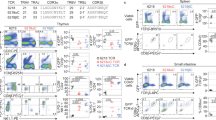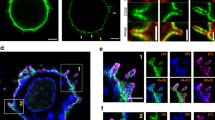Abstract
The recognition of foreign antigens by T lymphocytes is essential to most adaptive immune responses. It is driven by specific T-cell antigen receptors (TCRs) binding to antigenic peptide–major histocompatibility complex (pMHC) molecules on other cells1. If productive, these interactions promote the formation of an immunological synapse2,3. Here we show that synaptic TCR–pMHC binding dynamics differ significantly from TCR–pMHC binding in solution. We used single-molecule microscopy and fluorescence resonance energy transfer (FRET) between fluorescently tagged TCRs and their cognate pMHC ligands to measure the kinetics of TCR–pMHC binding in situ. When compared with solution measurements, the dissociation of this complex was increased significantly (4–12-fold). Disruption of actin polymers reversed this effect, indicating that cytoskeletal dynamics destabilize this interaction directly or indirectly. Nevertheless, TCR affinity for pMHC was significantly elevated as the result of a large (about 100-fold) increase in the association rate, a likely consequence of complementary molecular orientation and clustering. In helper T cells, the CD4 molecule has been proposed to bind cooperatively with the TCR to the same pMHC complex. However, CD4 blockade had no effect on the synaptic TCR affinity, nor did it destabilize TCR–pMHC complexes, indicating that the TCR binds pMHC independently of CD4.
This is a preview of subscription content, access via your institution
Access options
Subscribe to this journal
Receive 51 print issues and online access
$199.00 per year
only $3.90 per issue
Buy this article
- Purchase on Springer Link
- Instant access to full article PDF
Prices may be subject to local taxes which are calculated during checkout




Similar content being viewed by others
References
Davis, M. M. et al. T cells as a self-referential, sensory organ. Annu. Rev. Immunol. 25, 681–695 (2007)
Grakoui, A. et al. The immunological synapse: a molecular machine controlling T cell activation. Science 285, 221–227 (1999)
Monks, C. R., Freiberg, B. A., Kupfer, H., Sciaky, N. & Kupfer, A. Three-dimensional segregation of supramolecular activation clusters in T cells. Nature 395, 82–86 (1998)
Corr, M. et al. T cell receptor-MHC class I peptide interactions: affinity, kinetics, and specificity. Science 265, 946–949 (1994)
Matsui, K., Boniface, J. J., Steffner, P., Reay, P. A. & Davis, M. M. Kinetics of T-cell receptor binding to peptide/I-Ek complexes: correlation of the dissociation rate with T-cell responsiveness. Proc. Natl Acad. Sci. USA 91, 12862–12866 (1994)
Krogsgaard, M. et al. Evidence that structural rearrangements and/or flexibility during TCR binding can contribute to T cell activation. Mol. Cell 12, 1367–1378 (2003)
Irvine, D. J., Purbhoo, M. A., Krogsgaard, M. & Davis, M. M. Direct observation of ligand recognition by T cells. Nature 419, 845–849 (2002)
Sykulev, Y., Joo, M., Vturina, I., Tsomides, T. J. & Eisen, H. N. Evidence that a single peptide-MHC complex on a target cell can elicit a cytolytic T cell response. Immunity 4, 565–571 (1996)
Bell, G. I. Models for the specific adhesion of cells to cells. Science 200, 618–627 (1978)
Dustin, M. L., Ferguson, L. M., Chan, P. Y., Springer, T. A. & Golan, D. E. Visualization of CD2 interaction with LFA-3 and determination of the two-dimensional dissociation constant for adhesion receptors in a contact area. J. Cell Biol. 132, 465–474 (1996)
Zhu, D. M., Dustin, M. L., Cairo, C. W. & Golan, D. E. Analysis of two-dimensional dissociation constant of laterally mobile cell adhesion molecules. Biophys. J. 92, 1022–1034 (2007)
Lillemeier, B. F. et al. TCR and LAT occur in separate membrane domains and concatenate during activation. Nature Immunol. 11, 90–96 (2010)
Lillemeier, B. F., Pfeiffer, J. R., Surviladze, Z., Wilson, B. S. & Davis, M. M. Plasma membrane-associated proteins are clustered into islands attached to the cytoskeleton. Proc. Natl Acad. Sci. USA 103, 18992–18997 (2006)
Schamel, W. W. et al. Coexistence of multivalent and monovalent TCRs explains high sensitivity and wide range of response. J. Exp. Med. 202, 493–503 (2005)
Garcia, K. C. et al. Structural basis of plasticity in T cell receptor recognition of a self peptide-MHC antigen. Science 279, 1166–1172 (1998)
Wang, J. et al. Atomic structure of an αβ T cell receptor (TCR) heterodimer in complex with an anti-TCR Fab fragment derived from a mitogenic antibody. EMBO J. 17, 10–26 (1998)
Kaizuka, Y., Douglass, A. D., Varma, R., Dustin, M. L. & Vale, R. D. Mechanisms for segregating T cell receptor and adhesion molecules during immunological synapse formation in Jurkat T cells. Proc. Natl Acad. Sci. USA 104, 20296–20301 (2007)
van der Merwe, P. A., McNamee, P. N., Davies, E. A., Barclay, A. N. & Davis, S. J. Topology of the CD2–CD48 cell-adhesion molecule complex: implications for antigen recognition by T cells. Curr. Biol. 5, 74–84 (1995)
Choudhuri, K., Wiseman, D., Brown, M. H., Gould, K. & van der Merwe, P. A. T-cell receptor triggering is critically dependent on the dimensions of its peptide-MHC ligand. Nature 436, 578–582 (2005)
Xiong, Y., Kern, P., Chang, H. & Reinherz, E. T cell receptor binding to a pMHCII ligand is kinetically distinct from and independent of CD4. J. Biol. Chem. 276, 5659–5667 (2001)
Li, Q. J. et al. CD4 enhances T cell sensitivity to antigen by coordinating Lck accumulation at the immunological synapse. Nature Immunol. 5, 791–799 (2004)
Krogsgaard, M. et al. Agonist/endogenous peptide-MHC heterodimers drive T cell activation and sensitivity. Nature 434, 238–243 (2005)
Fricke, G. M. & Thomas, J. L. Receptor aggregation by intermembrane interactions: a Monte Carlo study. Biophys. Chem. 119, 205–211 (2006)
Weikl, T. R. & Lipowsky, R. Pattern formation during T-cell adhesion. Biophys. J. 87, 3665–3678 (2004)
Tsumoto, K. et al. Highly efficient recovery of functional single-chain Fv fragments from inclusion bodies overexpressed in Escherichia coli by controlled introduction of oxidizing reagent–application to a human single-chain Fv fragment. J. Immunol. Methods 219, 119–129 (1998)
Moertelmaier, M., Brameshuber, M., Linimeier, M., Schütz, G. J. & Stockinger, H. Thinning out clusters while conserving stoichiometry of labeling. Appl. Phys. Lett. 87, 263903 (2005)
Dai, S. et al. Crossreactive T cells spotlight the germline rules for αβ T cell-receptor interactions with MHC molecules. Immunity 28, 324–334 (2008)
Tynan, F. E. et al. A T cell receptor flattens a bulged antigenic peptide presented by a major histocompatibility complex class I molecule. Nature Immunol. 8, 268–276 (2007)
Wu, L. C., Tuot, D. S., Lyons, D. S., Garcia, K. C. & Davis, M. M. Two-step binding mechanism for T-cell receptor recognition of peptide MHC. Nature 418, 552–556 (2002)
Huppa, J. B., Gleimer, M., Sumen, C. & Davis, M. M. Continuous T cell receptor signaling required for synapse maintenance and full effector potential. Nature Immunol. 4, 749–755 (2003)
Acknowledgements
We thank F. E. Tynan, A. K. Chakraborty and S. R. Quake for helpful discussions, and P. P. J. Ebert for help with the flow cytometry experiments. This work was supported by grants from the National Institutes of Health (RO1 AI52211) and the Howard Hughes Medical Institute to M.M.D. J.B.H. is partly supported by the Immunology Frontier Research Center (iFREC) consortium, M.A.M. received a postdoctoral fellowship from the Wilhelm Macke Stiftung, and E.W.N. from the American Cancer Society’s Steven Stanley and Edward Albert Bielfelt Fund. L.O.K. is supported by a National Science Foundation predoctoral fellowship. M.A., M.B. and G.J.S. received grants from the Austrian Science Fund (project Y250-B10) and the GEN-AU project of the Austrian Ministry for Science and Research.
Author Contributions J.B.H., G.J.S. and M.M.D. conceived the project. Reagents and experimental systems were designed and tested by J.B.H. unless indicated otherwise. M.A., M.A.M. and G.J.S. provided important expertise in single-molecule microscopy. M.A. conducted all single dye tracing experiments and all smFRET experiments performed in Linz. J.B.H. conducted all bulk FRET experiments and all smFRET experiments at Stanford. J.B.H. and M.A.M. laid the experimental foundation in the initial phase of the project. M.A.M. provided important expertise in setting up the microscope system at Stanford. B.F.L. provided the expression system for ICAM-1 and B7-1. E.W.N. conducted all SPR measurements. M.B. conducted all TOCCSL experiments. L.O.K. and B.F.L. contributed important ideas. J.B.H. and M.M.D. wrote the manuscript.
Author information
Authors and Affiliations
Corresponding author
Ethics declarations
Competing interests
The authors declare no competing financial interests.
Supplementary information
Supplementary Information
This file contains Supplementary Figures 1-23 with Legends and Supplementary References. (PDF 2050 kb)
Rights and permissions
About this article
Cite this article
Huppa, J., Axmann, M., Mörtelmaier, M. et al. TCR–peptide–MHC interactions in situ show accelerated kinetics and increased affinity. Nature 463, 963–967 (2010). https://doi.org/10.1038/nature08746
Received:
Accepted:
Issue Date:
DOI: https://doi.org/10.1038/nature08746
This article is cited by
-
PIEZO1 mechanically regulates the antitumour cytotoxicity of T lymphocytes
Nature Biomedical Engineering (2024)
-
Functionalized tetrahedral DNA frameworks for the capture of circulating tumor cells
Nature Protocols (2024)
-
Membrane-anchored DNA nanojunctions enable closer antigen-presenting cell–T-cell contact in elevated T-cell receptor triggering
Nature Nanotechnology (2023)
-
A transformer-based model to predict peptide–HLA class I binding and optimize mutated peptides for vaccine design
Nature Machine Intelligence (2022)
-
LAG3 associates with TCR–CD3 complexes and suppresses signaling by driving co-receptor–Lck dissociation
Nature Immunology (2022)
Comments
By submitting a comment you agree to abide by our Terms and Community Guidelines. If you find something abusive or that does not comply with our terms or guidelines please flag it as inappropriate.



